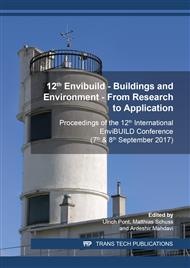[1]
M. Ibrahim, E. Wurtz, P. H. Biwole, P. Achard, and H. Sallee, Hygrothermal performance of exterior walls covered with aerogel-based insulating rendering,, Energy and Buildings, vol. 84, (2014) 241–251.
DOI: 10.1016/j.enbuild.2014.07.039
Google Scholar
[2]
M. Santamouris and E. Dascalaki, Passive retrofitting of office buildings to improve their energy performance and indoor environment: The OFFICE project,, Building and Environment, vol. 37, (2002) 575–578.
DOI: 10.1016/s0360-1323(02)00004-5
Google Scholar
[3]
J.L.M. Hensen and R. Lamberts, Building performance simulation for design and operation,, Spon Press,London and New york, (2011).
Google Scholar
[4]
V. Monetti, E. Davin, E. Fabrizio, P. Andre, and M. Filippi, Calibration of building energy simulation models based on optimization: A case study,, Energy Procedia, vol. 78, (2015) 2971–2976.
DOI: 10.1016/j.egypro.2015.11.693
Google Scholar
[5]
Fixit group, Information on http://www.fixit.ch/Home/Produkte/Restaurierungs-und-Sanierungsprodukte/. Last accessed on 10.06.(2017).
Google Scholar
[6]
M. Schuss, A. Mahdavi, U. Pont, C. Sustr, S. Aien, K. Ghazi Wakili, and T. Stahl, Strukturierte Aerogelputze,, Bauphysik-Kalender 2017, 1, Ernst & Sohn. Architektur und technische Wissenschaften Berlin, Berlin, ISBN: 9783433031698, (2017) 153 – 175.
DOI: 10.1002/9783433607794.ch4
Google Scholar
[7]
IBP, WUFI® Pro version 5.1, Fraunhofer Institute for Building Physics, Holzkirchen, Germany, (2011), Information on http://www.WUFI. de/index e.html. Last accessed on 10.06.(2017).
Google Scholar
[8]
H. M. Künzel, Simultaneous heat and moisture transport in building components one- and two-dimensional calculation using simple parameters,, Fraunhofer IRB Verlag Suttgart, ISBN 3-8167-4103-7, (1995).
Google Scholar
[9]
EN 15026, Hygrothermal performance of building components and building elements: Assessment of moisture transfer by numerical simulation,, ISBN: 9780580547416, April (2007).
DOI: 10.3403/30124008u
Google Scholar
[10]
Meteonorm Software, Information on http://www.meteonorm.com/en/product/productpage/ meteonorm-software/. Last accessed on 10.06.(2017).
Google Scholar
[11]
F. Tahmasebi and A. Mahdavi, A two-staged simulation model calibration approach to virtual sensors for building performance data,, 13th Conference of International Building Performance Simulation Association, Chambéry, France, August 26-28, (2013) 608–613.
DOI: 10.26868/25222708.2013.1088
Google Scholar


